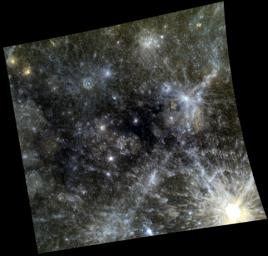At the center of this scene is an area of dark, deep blue terrain. MESSENGER scientists refer to this as the "Low Reflectance Material (LRM)." Besides being dark across all wavelengths, the LRM reflects less light at longer wavelengths than does average Mercury material. Our eyes perceive light at the long wavelength end of the visible spectrum as red, and the short end as blue. Hence the LRM is said to have "blue" color relative to Mercury as a whole. Named craters in the scene include Kuiper, Yeats, Dominici, and Homer.
This image was acquired as part of MDIS's 8-color base map. The 8-color base map is composed of WAC images taken through eight different narrow-band color filters and covers more than 99% of Mercury's surface with an average resolution of 1 kilometer/pixel. The highest-quality color images are obtained for Mercury's surface when both the spacecraft and the Sun are overhead, so these images typically are taken with viewing conditions of low incidence and emission angles.
Date acquired: April 10, 2011
Image Mission Elapsed Time (MET): 210935602, 210935622, 210935606
Image ID: 114272, 114277, 114273
Instrument: Wide Angle Camera (WAC) of the Mercury Dual Imaging System (MDIS)
WAC filters: 9, 7, 6 (996, 748, 433 nanometers) in red, green, and blue
Center Latitude: -2.50°
Center Longitude: 316.5° E
Resolution: 975 meters/pixel
Scale: The scene is about 1040 km (645 mi.) wide.
Incidence Angle: 13.3°
Emission Angle: 14.7°
Phase Angle: 28.0°
The MESSENGER spacecraft is the first ever to orbit the planet Mercury, and the spacecraft's seven scientific instruments and radio science investigation are unraveling the history and evolution of the Solar System's innermost planet. Visit the Why Mercury? section of this website to learn more about the key science questions that the MESSENGER mission is addressing. During the one-year primary mission, MDIS acquired 88,746 images and extensive other data sets. MESSENGER is now in a year-long extended mission, during which plans call for the acquisition of more than 80,000 additional images to support MESSENGER's science goals.
These images are from MESSENGER, a NASA Discovery mission to conduct the first orbital study of the innermost planet, Mercury. For information regarding the use of images, see the MESSENGER image use policy.

 Planetary Data System
Planetary Data System












